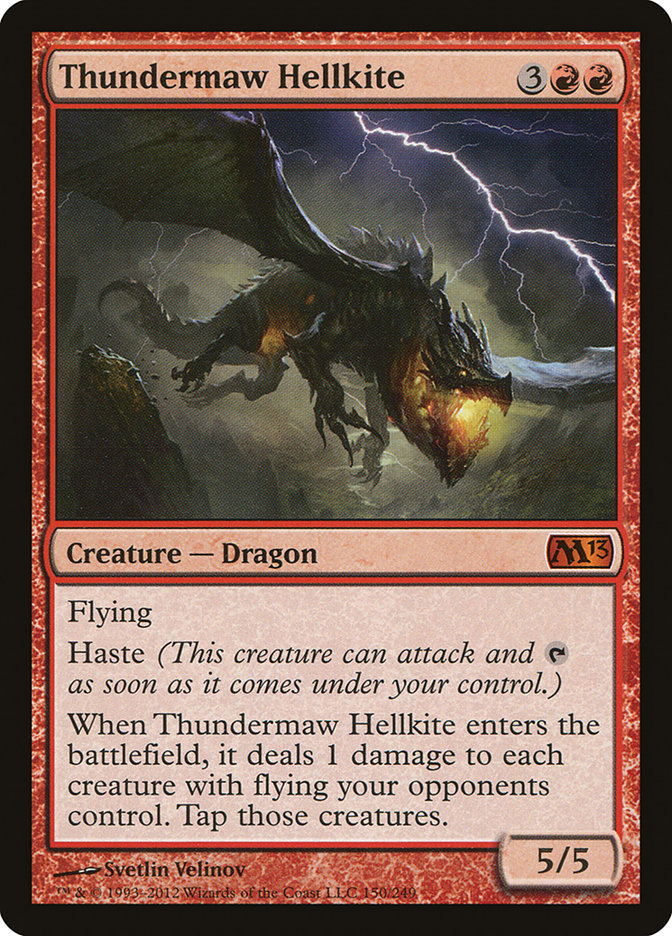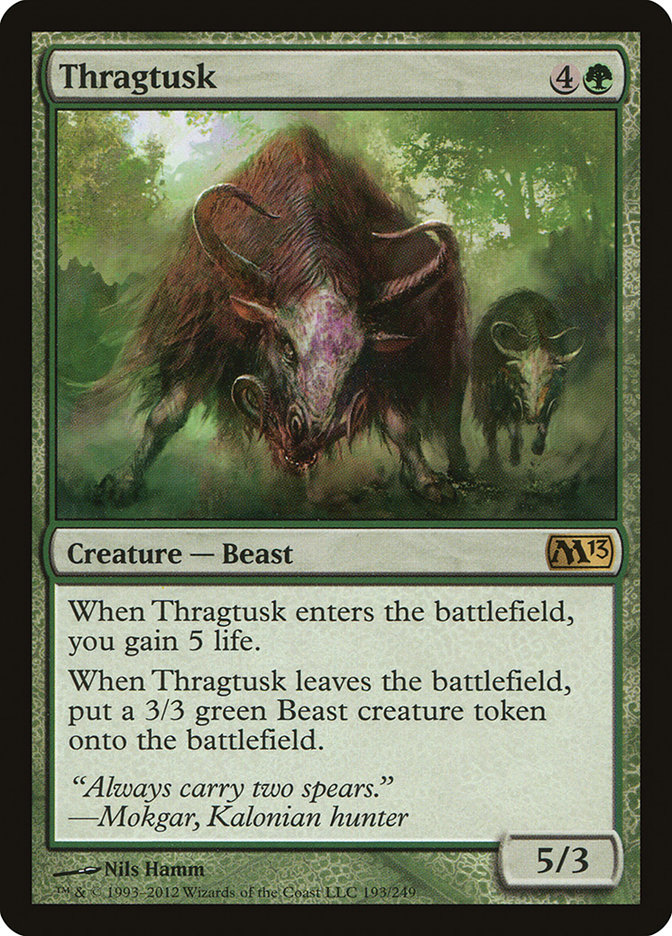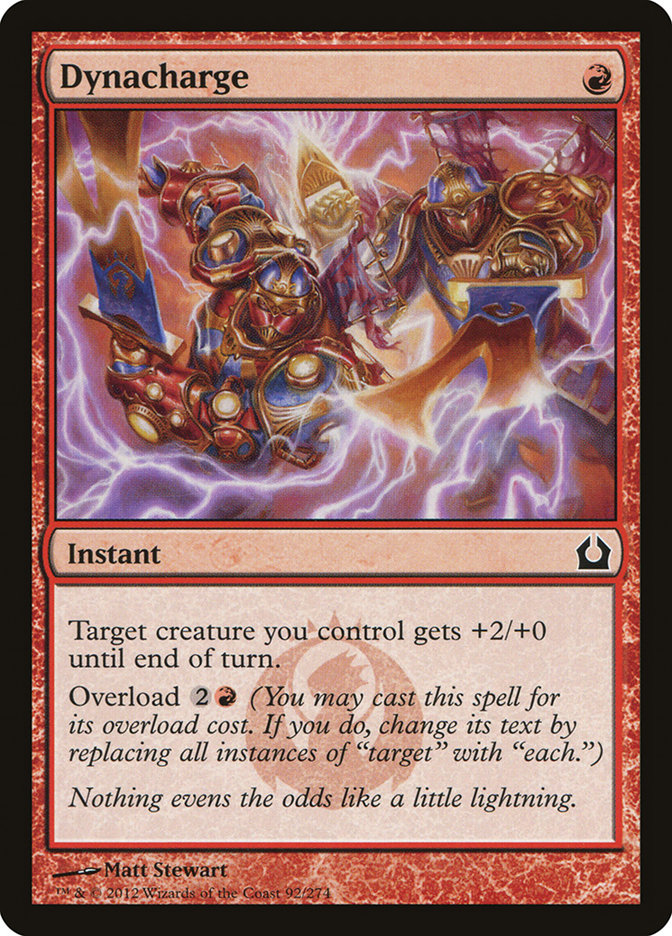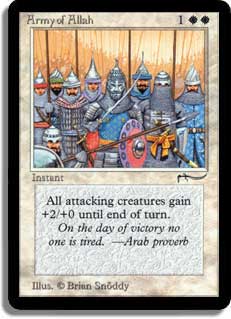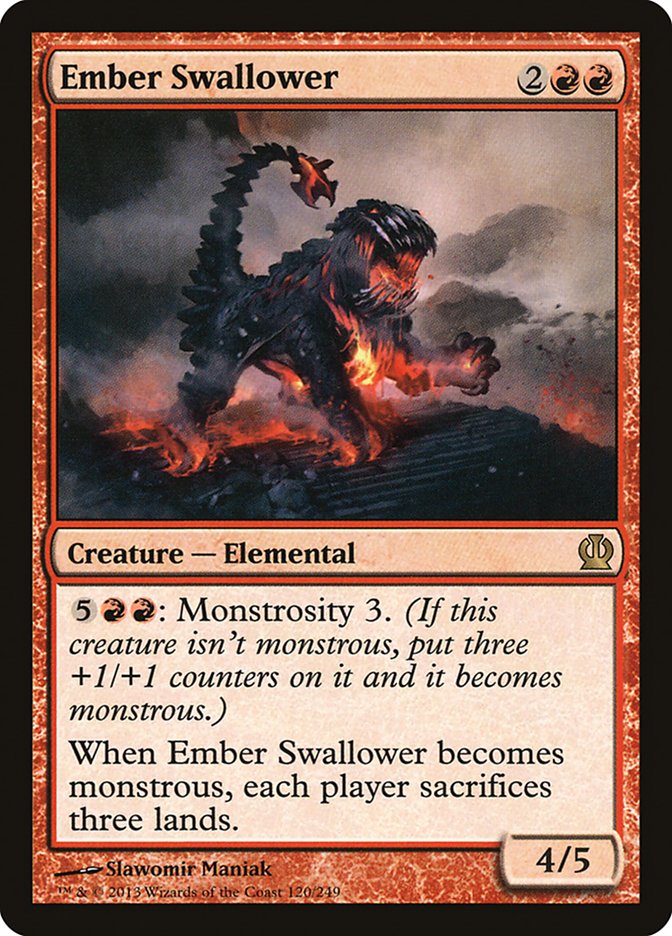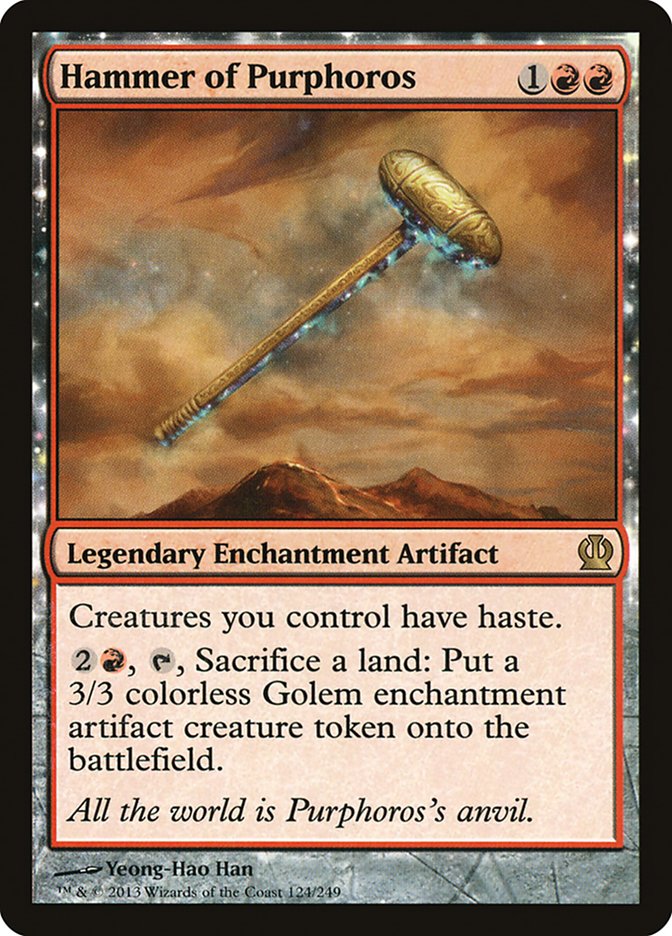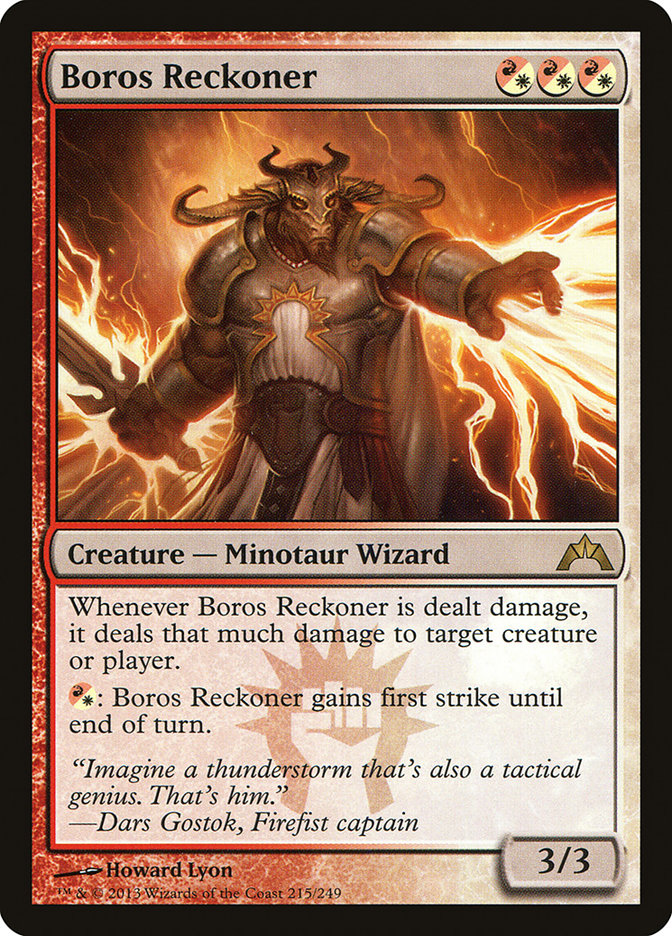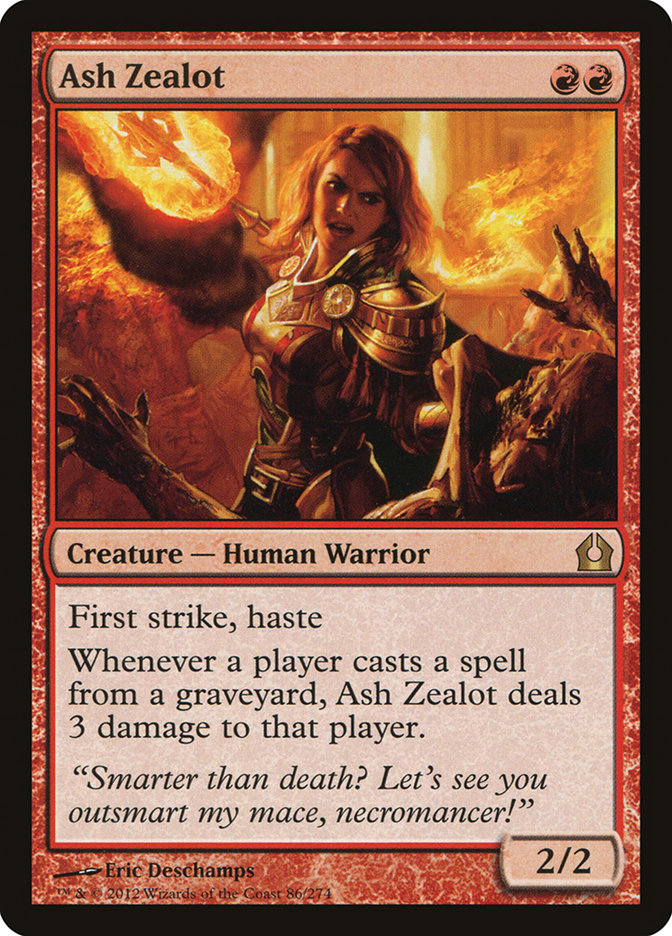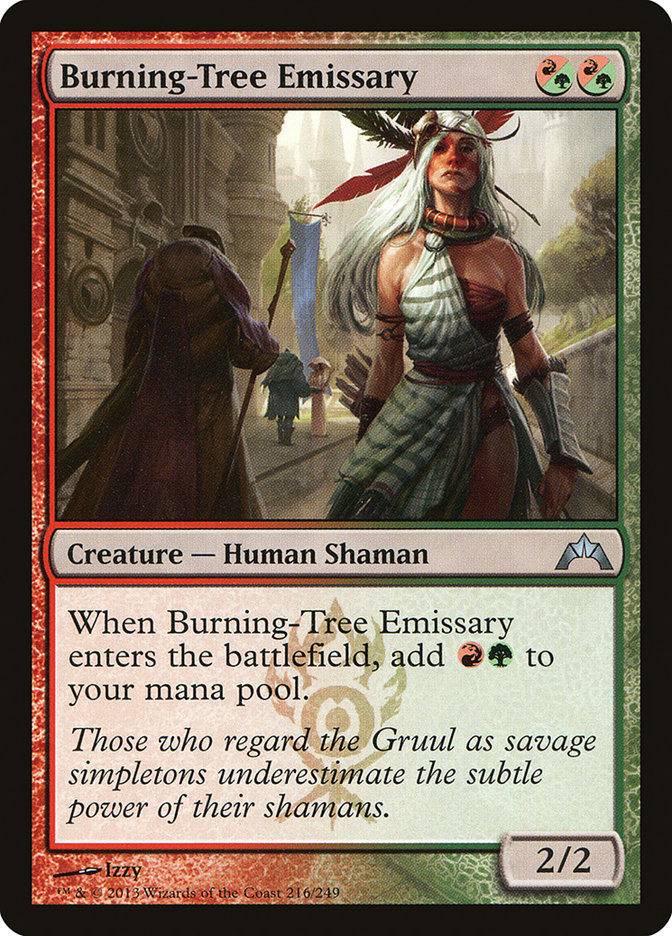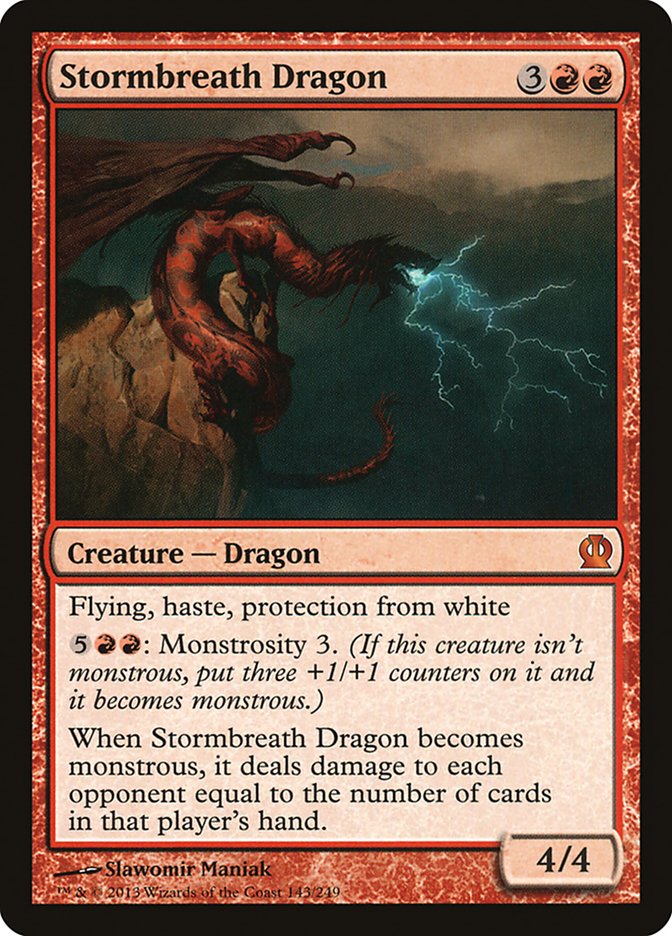I didn’t think it was going to happen, but I held out hope until I saw the full M14 spoiler. At that point I knew my dreams were going to be dashed. They didn’t reprint my favorite creature in Standard, perhaps my favorite creature in years. Maybe it has yet to be spoiled in Theros, but frankly, I doubt it. And so I must say, with great regret, goodbye to the greatest creature in Standard.
Farewell, Big Mouth.
Some people, I’m sure, are going to cry out, “No way! The best creature is obviously Thragtusk!” To them I say, just look at the two creatures side by side and tell me that.
The answer is obvious, isn’t it?
When M13 was first spoiled, a lot of people naysayed the expected power of Thundermaw Hellkite, saying, among other things, that it just dies to any removal. This isn’t strictly true, but it does certainly die to a lot of cards. It could also be countered if it wasn’t being helped out by Cavern of Souls. Five mana is a lot of mana, certainly, but one thing I kept thinking about was the way that Beacon of Destruction was just a powerhouse when it was in print and how effectively it was put to use in Kuroda Red and, to a much lesser extent, my Johnny Walker Red deck from 2007 that Zac Hill played to success at Worlds that year. Five damage with a single card is just a huge amount of damage. The idea that the card could just keep being used turn after turn if they didn’t answer it was more than a little mind-blowing.
I think, as time has passed, the card has more than proved itself as a power. Even when it isn’t murdering the skies of tiny pesks, the card just hits so hard that it was basically the backbone of decks like this:
Creatures (31)
- 3 Borderland Ranger
- 4 Arbor Elf
- 4 Falkenrath Aristocrat
- 4 Thundermaw Hellkite
- 4 Flinthoof Boar
- 4 Burning-Tree Emissary
- 4 Ghor-Clan Rampager
- 4 Gyre Sage
Lands (23)
Spells (6)

If you look at Cedric’s deck, the whole point of it is to just put down a reasonable aggressive base and then ruin the opponent’s game with Thundermaw Hellkite (and, to a lesser extent against most opponents, Falkenrath Aristocrat). A repeatable damage source in the air is just incredible, even if your opponent is managing to recover life with Thragtusk.
Last year, just before the rotation out of New Phyrexia and friends, I wrote an article called The Problem with Standard Red Decks (And How to Solve It) in which I detailed that the issue of the moment for red decks was not Thragtusk but rather the fight against another issue entirely: Gut Shot and Vapor Snag. It was a different metagame, of course, but in the article I express the solution to the Thragtusk issue:
So how do you beat Thragtusk? You make sure that your deck is capable of taking out huge chunks of life. This is very doable if you choose to play the right cards. If you want to do more, you play actively anti-Thragtusk cards in your board.
Certainly you’re not pumping the fist if your opponent casts one. And you may be weeping if they cast another or Restoration Angel it. But a single Thragtusk is not all she wrote.
It’s funny because one of the things that a lot of red decks decided to do, among those who tried to go that route, was go for the short-game swarm and pray for no timely Bonfire of the Damned from a deck like Jund or add on to their plan a swarm with a Thundermaw Hellkite tacked on the top. In essence, Cedric’s deck above is basically has this plan—it can provide a strong initial beatdown and then has a secondary game plan in the form of absurd monsters in the air.
One exciting thing for all red decks is that this concern is basically gone. Not only is Thragtusk going the way of the dodo, but so is Huntmaster of the Fells. While there are still some real boogeymen (Archangel of Thune, Blood Baron of Vizkopa, and Fiendslayer Paladin may well be the cards we hear hushed stories about over the campfire), red doesn’t have to fear the same style of problem that it once did, so even though we lose one of its most potent weapons in Thundermaw Hellkite, I do think the bar is lower for what it needs to do.
That doesn’t change the real problem of Sphinx’s Revelation, of course, and if you read last week’s article The Past as Preamble, you know that red decks had their successes in Block, the building base upon which Standard will come, but Sphinx’s Revelations decks out performed them.
For reference, here is the most recent 4-0 red deck available from Return to Ravnica Block Daily Events as of the time of this writing:
Creatures (36)
- 4 Ash Zealot
- 4 Gore-House Chainwalker
- 4 Rakdos Cackler
- 4 Burning-Tree Emissary
- 4 Legion Loyalist
- 4 Firefist Striker
- 4 Foundry Street Denizen
- 4 Boros Reckoner
- 4 Rubblebelt Maaka
Lands (19)
- 19 Mountain
Spells (5)
Sideboard

This deck is, as Patrick Sullivan discussed with his own Boros deck for Pro Tour Dragon’s Maze, much more of a White Weenie deck than a red deck as we typically think about them. Heck, it even has this ancient White Weenie card:
If I think about how a deck like this curves out, it is a little misleading because of Rubblebelt Maaka and Dynacharge. That being said, I am going to quasi-arbitrarily assign the casting cost of Dynacharge as three copies of a 3CC and one of a 1CC and Rubblebelt Maaka as three copies of a 1CC and one copy of a 4CC. It isn’t perfect, but I think it is better than calling it four 1CC and four 4CC. With that done, we have the curve as this:
1CC: 16
2CC: 17
3CC: 7
4CC: 1
While I think this kind of deck has real reason to be played when the format is much more limited in its card selection, it loses a lot of incentives to be played once we have more cards. All told, there are 664 legal cards for Return to Ravnica Block; once we add on M14 and Theros, we’re going to get about 450 or so more. There may be room for a swarm-like deck like this, but I think it is going to be overshadowed by a more traditional approach to red that includes a bit of burn.
Building the Base
My approach to deckbuilding sometimes includes a bit of brute force. One part of the plan for deckbuilding isn’t building lists of decks but lists of potential pieces. In this way, I’m not concerned yet with sideboard cards; I’m primarily concerned with cards that might make sense to play in potential maindecks.
A key to this approach is to allow yourself to be a little wild; there is always plenty of time to pare it back later. Right now you’re just trying to think about what could be a part of a cohesive whole. One thing about doing this, though, is that you sometimes end up with strange things in your lists. At the same time, these strange things, while they usually end up on the scrapheap, sometimes end up in the champion’s seat.
Here is my RTR + M14 list for red decks right now, ordered in Sligh-like fashion by casting cost and split between creature and spell:
One
Foundry Street Denizen
Legion Loyalist
Blistercoil Weird
Nivmagus Elemental
Rakdos Cackler
Mugging
Rubblebelt Maaka
Shock
Two
Ash Zealot
Firefist Striker
Goblin Diplomats
Goblin Shortcutter
Gore-House Chainwalker
Skinbrand Goblin
Young Pyromancer
Frostburn Weird
Rakdos Shred-Freak
Burning-Tree Emissary
Mutavault
Madcap Skills
Mizzium Mortars
Skullcrack
Armed // Dangerous
Turn // Burn
Ratchet Bomb
Three
Chandra’s Phoenix
Guttersnipe
Hellraiser Goblin
Mindsparker
Pyrewild Shaman
Cryptborn Horror
Boros Reckoner
Act of Treason
Annihilating Fire
Dynacharge
Flames of the Firebrand
Massive Raid
Scorchwalker
Toil // Trouble
Four
Ogre Battledriver
Haunted Plate Mail
Volatile Rig
Burning Earth
Chandra, Pyromaster
Shiv’s Embrace
Five
Awaken the Ancient
Scourge of Valkas
Wrecking Ogre
Pyromancer’s Gauntlet
Six-Plus
Molten Primordial
Shivan Dragon
Explosive Impact
Volcanic Geyser
I have some cards listed slightly off of their actual official casting cost on purpose. Awaken the Ancient, for example, strikes me as a card I want to be attacking with, and thus it has an effective five casting cost. Mutavault has “no” cost, but activating it and attacking with it costs “two.” Both are listed in the creature area, even though neither is. If you add in splashing a color, tons of other options open up, but this is a good starting place. Many of the cards are very marginal and I’m sure wouldn’t end up in the final list of any deck I’d end up wanting to play, but they are still doing enough of something that they feel worthy of consideration as long as we are staying mono-red.
But without dipping into other colors, it really does feel like our theoretical red deck is going to need some help. Thankfully, Theros has a few cards among the small number spoiled that might just come to save the day. (Consider yourself warned if you don’t want to see spoilers.)
A Few Theros Gems
There are quite a few cards that have already been spoiled that might also end up making the cut. Bringing into the discussion the new cards with the same amount of leeway as I’m using above would grow this article into one of much larger proportions. A card like Magma Jet is exciting to see coming back, but it doesn’t create a wild change in how we can see the world.
That being said, there are a couple of cards that I’m looking at that seem like they’re going to get a lot of play in decks that might emerge in the new Standard and are also doing something quite new. In addition, they actually have images out there that look very much like they are real, so there is some solid certainty that they exist. Before we get into the decks, here are those gems:
These three cards are all of moderate price (three or four mana) but importantly are all doing something a bit radical, something that could really shift the play of a game. Of the three, the one that most immediately can be placed into a deck is the new God of Fire, Forge[/author]“]Purphoros, God of the [author name="Forge"]Forge[/author].
At four mana, this is a lot to invest in a swarm-style deck like we saw in Return to Ravnica Block, but it is still quite appealing. Even if you don’t create the “God” figure by having out RRRRR in casting costs in play (or, really, RRRR since the card supplies the first red mana symbol on its own), the two abilities of Forge[/author]“]Purphoros, God of the [author name="Forge"]Forge[/author] both are incredibly relevant. The triggered ability may often have the wind out of its sails by the time you drop it down, but being indestructible means that you can generally count on it being there as the game progresses. Tacking on that extra damage really can add up.
The activated ability is also not irrelevant, particularly if you draw the card late enough that you’re flooding or if you have cheap haste creatures hiding in your hand (I’m talking to you, Legion Loyalist). If all of those things are in place, you’re looking at a combination that seems ripe for Purphoros.
And if you do just a little bit of work in maximizing your casting cost’s color requirements, Purphoros being a creature doesn’t seem out of line. How might we do that, I wonder?
Almost incredibly, these cards are practically screaming out, “Hey, remember that Block deck?!”
Well, I do. Let’s put a little feta cheese and olive oil on it and see what we can do.
Creatures (27)
- 4 Chandra's Phoenix
- 4 Ash Zealot
- 4 Rakdos Cackler
- 4 Burning-Tree Emissary
- 4 Legion Loyalist
- 4 Boros Reckoner
- 3 Purphoros, God of the Forge
Planeswalkers (1)
Lands (23)
Spells (9)

The deck that this is based on wasn’t a Thundermaw Hellkite deck, and neither is this, though it does end the curve higher than the original with actual four-mana spells you expect to cast. Now, some people are certain to yowl about the existence of four Mutavaults in the deck, particularly given the four Boros Reckoners, forgetting that the base of this deck ran nineteen Mountains before to great success with four Boros Reckoners. The extra mana is certainly all colorless, but it is worth it to get access to Mutavault and I’m not running any less red than the Block deck was.
Of course, I have shifted the deck away from being such a pure swarm as it once was. A part of the reason for that, though, is that the deck doesn’t require the same amount of single-mindedness that the other deck had. This deck could reasonably put down a fast clock, get the power of a swarm, and have access to an indestructible 6/5 God without any unreasonable draws. With the inclusion of Hammer of Purphoros, it’s actually possible to get draws that include a hasty 6/5 coming on the turn it comes into play!
Now, one could try to maximize that effect, but I’m inclined to believe that Hammer of Purphoros, while a potent ability, has such massive diminishing returns that the effect isn’t worth it. If you’re more into the idea of being comborific, perhaps this is more your speed:
Creatures (24)
- 4 Chandra's Phoenix
- 4 Ash Zealot
- 4 Rakdos Cackler
- 4 Burning-Tree Emissary
- 4 Boros Reckoner
- 4 Purphoros, God of the Forge
Planeswalkers (3)
Lands (25)
- 25 Mountain
Spells (8)

This deck is far more interested in creating a hasty God than it should be. Chandra’s Phoenix doesn’t have quite as much oomph as it does in the other deck, but it still has seven ways to return (Magma Jet and Chandra, Pyromancer) and aside from that is still just a great card for such a cheap price.
This deck isn’t really going for sanity though. It is just trying to assemble Forge[/author]“]Purphoros, God of the [author name="Forge"]Forge[/author]; Hammer of Purphoros; and basically any other permanent. Rakdos Cackler is basically a nod to necessity (Cackler into Zealot can win games on its own, as can Cackler into anything aggressive), but the truly greedy could always cut Cackler in favor of Rakdos Shred-Freak.
Personally, I prefer the restraint of the first build, but your mileage may vary.
What if we went a little bigger?
Let’s look to Andrew Shrout for inspiration.
Creatures (16)
Lands (25)
Spells (19)
Sideboard

This deck is losing a few pieces, of course, but the idea is still completely rational: have powerful cards that hit hard and burn to go along the way. This Big Red idea is as old as Jamie Wakefield and Brian Kowal. Shrout’s build is a bit more single-minded, and it also took advantage of so many decks’ weakness to Burning Earth.
In reimagining this list, given that it loses 23 cards from the maindeck, we do have quite a bit to think about. We could do what Chris VanMeter did and dip into white to acquire awesome cards like Warleader’s Helix, but I’m going to limit this deck to examining “only” mono-red.
In my own work with Boros Reckoner, one of the best cards in red right now, I was able to discover that while I could get Reckoner reliably cast with nineteen red sources, it wasn’t effortless. There were times where I was waiting and frustrated with my inability to get the card out of my hand. Twenty felt a lot better, and 22 even more so. Given that I was imagining this as a “Big” deck, I was suddenly looking at 26 or even more lands. This brought me right back to one of the cards that I think is going to be incredibly monstrous in new Standard: Ember Swallower.
I already mentioned this card above, but I think that it is worth acknowledging just how devastating this card can potentially be. Without doing any work attempting to exploit the card and what it does, we’re still talking about an incredibly powerful body. At 4/5 for four, we’re still matching our power to our casting cost, but we also have the incredible upside of the activated ability.
Remember that enemy number one is likely to be a Sphinx’s Revelation deck. If we have an Ember Swallower in play, untapping with seven mana creates an incredibly huge monster and also helps us limit the late-game development of an opposing Sphinx’s Revelation deck. Particularly if we have other ways to make use of that mana, this can be impressive.
One way to do that is to simply up the curve. Scourge of Valkas is one way to go about that. Scourge of Valkas is actually a card that very much depresses me. It’s not that the card is bad by any means. It’s just that I so want it to be Thundermaw Hellkite practically every time. Alas. Alas, alas, alas. It still packs quite a wallop, and the pinging ability actually is moderately relevant. Then, of course, another card was spoiled:
A Stormbreath Dragon in play doesn’t come in for as big a hit as Thundermaw, but it is immune to Azorius Charm. Importantly, though, like Ember Swallower it can make life harder for a Sphinx’s Revelation player. I don’t expect that the card will replace the empty spot in my heart that is Thundermaw Hellkite, but it is a good start.
All told, this deck makes use of a lot of mana; in many ways, it is essentially a Ponza deck.
Creatures (17)
Planeswalkers (3)
Lands (28)
Spells (12)

There are no copies of Forge[/author]“]Purphoros, God of the [author name="Forge"]Forge[/author] in this deck, partly because it is so much harder to get enough devotion to make it worthwhile and also because it is so less good at using either the triggered ability or the activated one.
28 mana is a lot of mana, certainly, but between Encroaching Wastes, Ember Swallower, Mutavault, Stormbreath Dragon, and sacrificing lands to Hammer of Purphoros, it feels pretty solid. I’m still shaky on whether I want another Mountain to placate the Reckoners or not, but this is still a test deck and the full set isn’t out, so a lot of things can wildly change. This is, after all, an attempt at getting a head start, not the conclusion of the race.
I’ve made all of these early attempts mono-red, but it doesn’t need to be approached in that way in the slightest. Aurelia and her Helix beckon us into white, and Rakdos’s Return and Rakdos Keyrune could draw us into black. Ghor-Clan Rampager is still an incredible pull for green, and perhaps there are solid reasons to splash into blue. One of the things to remember is that mana right now is actually very good for a splash, so one shouldn’t feel too limited in the ways you go, though the more ambitious you are, the more you could be setting yourself up for a fall.
I hope you enjoyed these early takes on red in future Standard as we all await the sad passing of Thundermaw Hellkite.
Cheers, my friend.
Until next week,

